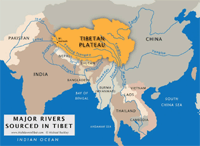Himalayan rivers water-sharing treaty
Water, not oil, is now the world's most important resource. Though we live on a planet covered by water, very little of it is accessible. More than 97 percent is seawater, which is too salty: at this point in time, desalination plants are very costly, in terms of both money and energy. Roughly another 2 percent of water resources are locked in ice and snow. That leaves a paltry 1 percent to supply drinking water, grow crops, run factories, cool power plants, and handle all the other key roles that water plays. And it's possible that up to half of that paltry 1 percent is polluted or contaminated water, which is not up to the task. As non-renewable groundwater resources are used up, the global supply of fresh water is dwindling at an alarming rate. This will lead to great tensions between nations over shared water resources.
Although there is fresh water deriving from the ice in the Arctic and Antarctic, most of it cannot be funnelled into usable fresh water for human consumption. Tibet is often referred to as the 'Third Pole', because it is the third-largest source of water locked in ice and snow. Tibet is unique in the world as a mass provider of fresh water, via rivers, to a dozen nations downstream. Tibet is the source of major headwaters for the rivers of Asia, and additionally provides key tributaries or feeders for other rivers (such as the Ganges). There is no parallel to this situation anywhere else on the planet.
"By having its hand on Asia's water tap, China is therefore acquiring tremendous leverage over its neighbours' behaviour. That the country controlling the headwaters of major Asian rivers is also a rising superpower, with a muscular confidence increasingly on open display, only compounds the need for international pressure on Beijing to halt its appropriation of shared waters and accept some form of institutionalised co-operation."
—Brahma Chellaney, New Delhi, August 2011, from a news article: Water is the new weapon in Beijing's armoury
Himalayan waters are precious because they in one way or another serve over a third of the planet's population. There are river-water treaties in place between India and Pakistan, and between India and Bangladesh. So why can't China be held accountable for its reckless use of water resources, and be brought to the negotiating table to make river water-sharing agreements with nations downstream? In the meantime, there should be a moratorium on big dam-building projects on the Tibetan plateau on rivers shared with nations downstream.
China is not only taking the greedy share of Tibet's water, the government is hell-bent on destructive practices that will exacerbate water problems—particularly in downstream nations. China's reckless engineering projects in Tibet include mega-dams and huge water diversion projects. Not to mention pollution from mining ventures.
China has never consulted lower riparian states before undertaking dam construction upstream, although dam-building is considered a trans-border water issue. China has not ratified the UN Convention on Non-Navigable Use of International Watercourses (1997). In rejecting this 1997 United Nations convention that lays down rules on shared water resources, Beijing asserted its claim that an upstream power has the right to assert absolute territorial sovereignty over the waters on its side of the international boundary — or the right to divert as much water as it wishes for its needs, irrespective of the effects on a downriver state. Today, by building megadams and reservoirs in its borderlands, China is working to re-engineer the flows of major rivers that are the lifeline of the nations downstream. China has resolutely refused to join the Mekong River Commission—set up in 1995 to resolve issues of shared concern by the countries along the Mekong. Burma has not joined the MRC either.
Pressure China to enter into appropriate water-sharing agreements
World Water Day, 22 March 2013

c/o International Tibet Network
1310 Fillmore Street, #401
San Francisco, CA 94115, USA
To: Environment Ministers of the Governments of India, Pakistan, Cambodia, Laos, Bhutan, Nepal, Bangladesh, Burma, Thailand and Vietnam.
cc Mrs Irina Bokuva, Director General, UNESCO
Your Excellencies,
Today is World Water Day 2013 in the United Nations International Year of Water Cooperation. We are writing to share our concerns about the impact of China's policies — especially its dam-building programme — on Asia's regional water security, and to urge your government to join forces with other downstream nations to pressure China to enter into appropriate water-sharing agreements.
Over the last sixty years, China's policies in Tibet, often called the earth's "Third Pole" and the source of Asia's great rivers, have led to widescale environmental degradation. This includes poisoned river and groundwater through unregulated mining, grasslands ecosystem degradation, and disrupted watershed and ecosystem services in the headwaters of these rivers, which has worsened already acute and chronic flooding downstream from Tibet, including your countries. In turn, global climate change is warming the Tibetan Plateau at twice the rate of the rest of the world, and the impact of this on Asia's water supplies is exacerbated by China's extensive dam-building programme, to harness hydro-power and divert water to mainland China. This programme threatens the safety, security, and sustainable livelihoods of more than one billion people downstream.
By claiming authority over the Water Tower of Asia, China is wielding considerable power over its neighbouring countries, yet it has not signed a single water sharing agreement. We urge you to act now to secure your future water supplies, by joining together with your counterparts in other nations downstream of the Tibetan plateau, and bring China to the negotiating table to sign appropriate regional and international water-sharing agreements.
Yours faithfully,
Ms Dhardon Sharling, Co Chair, on behalf of The International Tibet Network Secretariat, Tibetan Women's Association and Tibet Justice Centre
dhardon@tibetnetwork.org
China & the South China Sea
China currently has no river water-sharing agreements with any nation along its borders. The notion of 'sharing' does not seem to be part of the Chinese government mindset. Witness what is transpiring in the South China Sea, believed to sit atop vast oil and gas resources. China claims the South China Sea in its entirety as belonging to the PRC. This is in flagrant violation of international UN Convention on the 200-nautical-mile (equivalent to 370 km) Exclusive Economic Zone that most nations adhere to when it comes to fishing rights, oil and gas exploitation, mining, and so on. Chinese fishing vessels constantly test the waters on this, with vessels intercepted from South Korean waters (found to be using destructive illegal fishing methods) to the Philippines. Chinese fishing vessels intercepted at Scarborough Shoal in Philippine territorial waters, sparked an intense stand-off. Scarborough Shoal lies 230 kilometres from the nearest landfall in the Philippines (well within the UN Exclusive Economic Zone), but 1,200 km from the nearest landfall in China. And yet the PRC insists that it owns the shoal.
River conservation
In 1968, after a decade of political wrangling, the Wild and Scenic Rivers Act was signed into law in the US. The idea is to maintain parts of key rivers, or even whole rivers, from any commercial exploitation—particularly the scourge of dams. The initial act spared eight rivers and buffer zones around them from dams and development. By 2011, the list had grown to over 200 rivers in 39 states and Puerto Rico.
This model would work well for conserving rivers in the Himalayan region for future generations, but thus far there have been no initiatives to do any such thing. In a UN World Heritage Site called the Three Parallel Rivers, the land portion has been declared protected (Sichuan/Yunnan), but the rivers which give the site its name are not protected at all. Damming and diversion on all three rivers is proceeding as part of on-going Chinese engineering mega-projects.
